1. River Restoration
Vocation Heavy Construction Technology program (VHCT), South Park, CO.
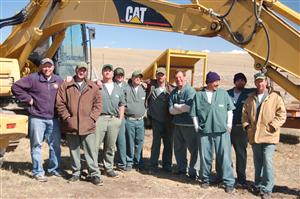 Fisheries biologists are capable of manipulating fish populations using the following three tools: regulations, stocking, and habitat alteration. If specific habitat elements are limiting for a given fish population or fish life stage, habitat restoration can have advantages over changing regulations or increasing fish stocking. Habitat restoration has the potential to increase the carrying capacity of a stream. Stocking fish will have short-term benefits by increasing fish numbers, but typically will not have the long-term benefits related to improving instream habitats. Changing regulations can improve the fishery if harvest is limiting a fish population, but it cannot do anything to increase the long-term potential of the stream to support more or larger fish. Typically, stream habitat restoration and enhancement will have the greatest benefit in degraded stream systems that are habitat-limited. Since many streams in Colorado are habitat-limited due to past human-caused disturbances, habitat improvements can be a very effective tool for increasing trout biomass (and/or densities) and for producing larger fish.
Fisheries biologists are capable of manipulating fish populations using the following three tools: regulations, stocking, and habitat alteration. If specific habitat elements are limiting for a given fish population or fish life stage, habitat restoration can have advantages over changing regulations or increasing fish stocking. Habitat restoration has the potential to increase the carrying capacity of a stream. Stocking fish will have short-term benefits by increasing fish numbers, but typically will not have the long-term benefits related to improving instream habitats. Changing regulations can improve the fishery if harvest is limiting a fish population, but it cannot do anything to increase the long-term potential of the stream to support more or larger fish. Typically, stream habitat restoration and enhancement will have the greatest benefit in degraded stream systems that are habitat-limited. Since many streams in Colorado are habitat-limited due to past human-caused disturbances, habitat improvements can be a very effective tool for increasing trout biomass (and/or densities) and for producing larger fish.
 The Vocational Heavy Construction Technology (VHCT) program exists in the Colorado Department of Corrections (CDOC) to provide student inmates with education and training that will equip them with basic life and work skills necessary to obtain employment with a construction company once they have completed their sentences. The Colorado Parks and Wildlife (CPW) has been the major customer of the program in South Park where natural river processes and aquatic habitats have been restored in over ten miles of public waters within the Upper South Platte River basin. In addition, over 150 inmate lives have been rehabilitated through the program with a recidivism rate for program graduates of about 12% compared to 60% recidivism for the Colorado Penal system. Successful graduates have the opportunity to secure a job within the construction industry. South Park was identified as an ideal location to implement the program because CPW owns or leases over 25 miles of public fishing waters in the Upper South Platte River basin, and its close proximity to the Buena Vista Correctional Facility. Much of the South Platte River habitat in South Park is degraded due to historic land use practices including excessive livestock grazing, willow removal and mining. Over 20 different habitat treatments have been implemented in South Park that fall within three functional categories: restoring river natural processes, reducing bank erosion, and enhancing aquatic habitat for sport fish. Treatments include the use of rock, stumps, logs and riparian plants for bank revegetation.
The Vocational Heavy Construction Technology (VHCT) program exists in the Colorado Department of Corrections (CDOC) to provide student inmates with education and training that will equip them with basic life and work skills necessary to obtain employment with a construction company once they have completed their sentences. The Colorado Parks and Wildlife (CPW) has been the major customer of the program in South Park where natural river processes and aquatic habitats have been restored in over ten miles of public waters within the Upper South Platte River basin. In addition, over 150 inmate lives have been rehabilitated through the program with a recidivism rate for program graduates of about 12% compared to 60% recidivism for the Colorado Penal system. Successful graduates have the opportunity to secure a job within the construction industry. South Park was identified as an ideal location to implement the program because CPW owns or leases over 25 miles of public fishing waters in the Upper South Platte River basin, and its close proximity to the Buena Vista Correctional Facility. Much of the South Platte River habitat in South Park is degraded due to historic land use practices including excessive livestock grazing, willow removal and mining. Over 20 different habitat treatments have been implemented in South Park that fall within three functional categories: restoring river natural processes, reducing bank erosion, and enhancing aquatic habitat for sport fish. Treatments include the use of rock, stumps, logs and riparian plants for bank revegetation.
Supporting materials/links:
2. Monitoring fisheries response to aquatic habitat improvements
In spite of society’s increasing awareness of the importance of rivers and streams for fresh water, food and recreational value, degradation of running waters is at an all time high (Gleick 2003). More than one-third of rivers in the United States are impaired or polluted (US EPA 2000). Freshwater withdrawals from rivers are so extreme that some major rivers no longer flow to the sea year round (NRC 1999). The extinction rates of freshwater fauna are five times that for terrestrial biota (Riccardi and Rasmussen 1999). The top two causal factors leading to extinctions of freshwater fishes during the 20th century were due to (1) habitat alterations and (2) the effects of nonnative species (Miller 1989). Fortunately, stream restoration efforts show promise as a means to aid species recovery, improve inland and coastal water quality and create new areas for wildlife habitat and recreational activities (Bernhardt et al. 2005).
 Within the continental United States, between $14-15 billion have been spent on stream and river restoration projects from 1990-2003. Currently, more than $1 billion per year is spent on stream restoration nationwide. A nationwide survey indicates that only about 10% of river restoration projects include any form of monitoring or assessment once they have been completed (Bernhardt et al. 2005). With so much money being spent on restoring rivers, there is a need to determine how effective river restoration projects have been at accomplishing the desired goals (i.e. to improve water quality, to manage riparian zones, to improve instream habitat, for fish passage, for bank stabilization, etc.).
Within the continental United States, between $14-15 billion have been spent on stream and river restoration projects from 1990-2003. Currently, more than $1 billion per year is spent on stream restoration nationwide. A nationwide survey indicates that only about 10% of river restoration projects include any form of monitoring or assessment once they have been completed (Bernhardt et al. 2005). With so much money being spent on restoring rivers, there is a need to determine how effective river restoration projects have been at accomplishing the desired goals (i.e. to improve water quality, to manage riparian zones, to improve instream habitat, for fish passage, for bank stabilization, etc.).
A recent quote in the journal Science reinforces the need for better post-project evaluation of stream restoration projects: “Much greater effort is needed to gather and disseminate data on restoration methods and outcomes, particularly given the magnitude of costs. It is unrealistic to expect that every restoration project will have extensive monitoring activities, but strategic pre- and post-assessments with standardized methods could enable restoration practitioners and managers to understand what types of activity are accomplishing their goals (Bernhardt et al. 2005).”
CPW is studying the following research questions related to river restoration activities: what is the change in salmonid biomass (quantity), individual fish size (quality) and fish utilization of habitat treatments in restored versus un-restored river segments? Candidate stream locations for conducting detailed studies on the fishery response to stream habitat restoration have the following characteristics: fish populations have stabilized post-whirling disease infection, multiple years of baseline fish data have been collected prior to stream restoration, CPW leases or owns stream public fishing access, proposed restoration sites have been identified, prioritized and funded allowing adequate time to collect good “before” data prior to construction and CPW personnel will be able to work closely with contractors on design and implementation of habitat treatments (design build).
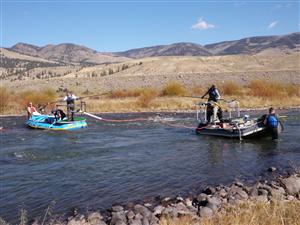 Stream habitat improvements are evaluated to quantify changes in salmonid biomass (quantity), individual fish size (quality), and fish utilization of habitat treatments in restored versus un-restored river segments. Before/ After/ Control/ Treatment (BACT) studies are conducted at appropriate site locations. A combination of field and theoretical results from studies are being used to evaluate the fishery response to stream habitat treatments. Research findings will generate information useful for quantifying how much improvement in the fishery can be expected from stream restoration projects. Results from these kinds of studies will refine stream aquatic habitat restoration techniques that will benefit anglers and improve trout fisheries.
Stream habitat improvements are evaluated to quantify changes in salmonid biomass (quantity), individual fish size (quality), and fish utilization of habitat treatments in restored versus un-restored river segments. Before/ After/ Control/ Treatment (BACT) studies are conducted at appropriate site locations. A combination of field and theoretical results from studies are being used to evaluate the fishery response to stream habitat treatments. Research findings will generate information useful for quantifying how much improvement in the fishery can be expected from stream restoration projects. Results from these kinds of studies will refine stream aquatic habitat restoration techniques that will benefit anglers and improve trout fisheries.
LITERATURE CITED
Bernhardt, E.S., M.A. Palmer, J.D. Allan, G. Alexander, K. Barnas, S. Brooks, J. Carr, S. Clayton, C. Dahm, J. Follstad-Shah, D. Galat, S. Gloss, P. Goodwin, D. Hart, B. Hassett, R. Jenkinson, S.Katz, G.M. Kondolf, P.S. Lake, R. Lave, J. L.Meyer, T.K. O’Donnell, L. Pagano, B. Powell, E. Sudduth. 2005. Synthesizing US River Restoration Efforts. Science 308: 636-637.
Gleick P.H. 2003. Global Freshwater Resources: Soft-Path Solutions for the 21st Century. Science 302:1524-1528.
Miller, R.R., J.D. Williams, and J.E. Williams. 1989. Extinctions in North American fishes during the past century. Fisheries 14:22-38.
National Research Council, NRC. 1999. Our Common Journey: A Transition Toward Sustainability. National Academy Press, Washington, DC.
Riccardi A., and J.B. Rasmussen. 1999. Extinction rates of North American freshwater fauna. Conservation Biology 13:1220-1222.
USEPA. 2000. National Water Quality Inventory. EPA Publ. 841-R-02-001, Washington, DC.
3. Creel studies
Monitoring angler use before/after aquatic habitat improvements are implemented
Little data exists documenting how angler use changes after river channels have been restored in Colorado. Information collected from angler-use of restored streams will be important in assessing the economic and social benefits realized from stream restoration projects. Anecdotal evidence collected from CPW aquatic biologists suggests that the restoration of degraded streams increases the recreational benefit to the angler. CPW has begun evaluating angler use in stream segments before and after stream restoration project completion. Prior to construction, creel surveys are conducted to quantify angler use specific to the un-restored river channel segment. Once stream restoration is completed, creel studies are completed periodically to quantify how angler use changes within restored river channels over time.
4. Fish passage studies
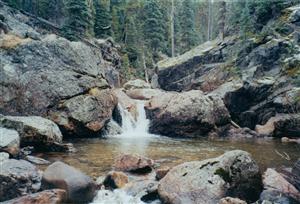 Vertical obstacles, such as waterfalls, in flowing water systems can affect fish populations in at least two ways. Impassable obstacles form barriers that fragment fish populations (Winston et al. 1991; Brown and Moyle 1993; Helfrich et al. 1999) by preventing the completion of migratory life histories, or dramatically reducing the available range (Dunham et al. 1997). Conversely, impassable obstacles protect fish populations from predators (Gregory and Griffith 2000), inter- or intra-specific competition (Fausch 1989; Young 1995; Harig et al. 2000), unwanted hybridization (Behnke 1992), or diseases that could threaten their long-term persistence.
Vertical obstacles, such as waterfalls, in flowing water systems can affect fish populations in at least two ways. Impassable obstacles form barriers that fragment fish populations (Winston et al. 1991; Brown and Moyle 1993; Helfrich et al. 1999) by preventing the completion of migratory life histories, or dramatically reducing the available range (Dunham et al. 1997). Conversely, impassable obstacles protect fish populations from predators (Gregory and Griffith 2000), inter- or intra-specific competition (Fausch 1989; Young 1995; Harig et al. 2000), unwanted hybridization (Behnke 1992), or diseases that could threaten their long-term persistence.
Therefore, it is important that fisheries managers have suitable tools for identifying and evaluating the barrier potential of instream structures. Most designed fish barriers are not monitored over time to determine whether they are functioning as desired by preventing upstream movement of undesirable aquatic organisms. Many human-made instream structures are identified in the field as potential barriers but rarely ever studied to validate assumptions. The CPW is conducting research on barriers by improving field and theoretical techniques for evaluating the barrier potential of instream obstacles. Information gained from barrier evaluation will be useful in modifying proposed or existing barrier designs to protect populations of Colorado fishes from contact with undesirable aquatic organisms including diseases and in connecting previously disconnected stream habitats to increase available fish species habitat.
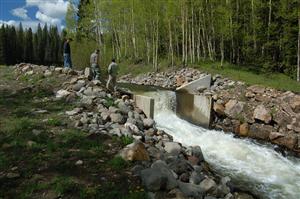 The CPW is actively developing field and theoretical techniques for evaluating the barrier potential of instream obstacles. This project involves multiple years of data collection on barriers statewide. Specific projects result from consultations with aquatic biologists requesting assistance with measuring the barrier potential of instream structures. Examples of past studies include evaluation of fish barrier function to protect cutthroat trout populations from whirling disease or non-native salmonids, evaluation of native sucker and sport-fish passage through whitewater kayak structures, evaluation of rock ramp structures to accommodate native non-game fish passage and evaluation of culvert structures for passage of various Colorado fishes. Data collected from field sites will be useful in developing species-specific fish passage criteria, evaluating existing instream obstacles, refinement of monitoring techniques for fish passage at potential barrier sites and improvement of theoretical techniques for evaluating fish passage (Kondratieff and Myrick 2006).
The CPW is actively developing field and theoretical techniques for evaluating the barrier potential of instream obstacles. This project involves multiple years of data collection on barriers statewide. Specific projects result from consultations with aquatic biologists requesting assistance with measuring the barrier potential of instream structures. Examples of past studies include evaluation of fish barrier function to protect cutthroat trout populations from whirling disease or non-native salmonids, evaluation of native sucker and sport-fish passage through whitewater kayak structures, evaluation of rock ramp structures to accommodate native non-game fish passage and evaluation of culvert structures for passage of various Colorado fishes. Data collected from field sites will be useful in developing species-specific fish passage criteria, evaluating existing instream obstacles, refinement of monitoring techniques for fish passage at potential barrier sites and improvement of theoretical techniques for evaluating fish passage (Kondratieff and Myrick 2006).
Field evaluation studies typically involve collecting fish from upstream of an instream obstacle (i.e. culvert, fish barrier, diversion structure, or other instream physical structure), recording individual fish data (species, lengths, weights, etc.), marking fish and releasing marked fish below the instream obstacle. Stream habitat located above the instream obstacle is monitored regularly over time to detect the presence or absence of marked fish. If marked fish are collected upstream of the obstacle, individual fish data is recorded before assigning a new mark to the fish and re-release them below the obstacle. Monitoring occurs over a range of flow conditions and under different portions of the seasonal stream hydrograph (pre- and post- snow melt) to try and determine if the obstacle is a barrier only under a specific range of flows and to what fish size classes.
In addition to this approach, CPW is experimenting with newer PIT tag technologies as means to monitor fish passage remotely and in real time. By monitoring potential barrier sites over time, we begin to gain understanding of the fish passage capabilities of various fish species by life stage over a range of flow conditions. This information assists with designing future structures that can either enhance or restrict fish passage of aquatic organisms depending on project goals.
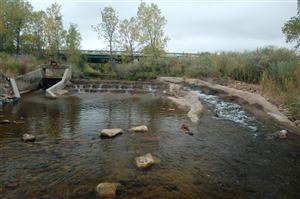 Theoretical evaluation of instream obstacles involves collecting physical habitat data in the vicinity of the potential obstacle and generating predictions for fish passage based on these measurements. Data collected from field studies are often compared to results gained from theoretical techniques in order to refine theoretical evaluations. Accurate theoretical techniques have the following advantages to field studies: 1) data collection is faster, 2) costs less and 3) conclusions can be made more quickly. The goal of this research is to refine theoretical techniques so that the barrier potential of instream obstacles to Colorado fishes, such as culverts, diversions, white water park structures and other potential fish barriers can be assessed quickly and accurately.
Theoretical evaluation of instream obstacles involves collecting physical habitat data in the vicinity of the potential obstacle and generating predictions for fish passage based on these measurements. Data collected from field studies are often compared to results gained from theoretical techniques in order to refine theoretical evaluations. Accurate theoretical techniques have the following advantages to field studies: 1) data collection is faster, 2) costs less and 3) conclusions can be made more quickly. The goal of this research is to refine theoretical techniques so that the barrier potential of instream obstacles to Colorado fishes, such as culverts, diversions, white water park structures and other potential fish barriers can be assessed quickly and accurately.
LITERATURE CITED
Behnke, R. J. 1992. Native trout of western North America. Monograph 6. American Fisheries Society, Bethesda, Maryland.
Brown, L. R. and P. B. Moyle. 1993. Distribution, ecology, and status of the fishes of the San Joaquin River drainage, California. California Fish and Game 79:96-114.
Dunham, J. B., G. L. Vinyard, and B. E. Rieman. 1997. Habitat fragmentation and extinction risk of Lahontan cutthroat trout. North American Journal of Fisheries Management 17:1126-1133.
Fausch, K. D. 1989. Do gradient and temperature affect distributions of, and interactions between, brook charr (Salvelinus fontinalis) and other resident salmonids in streams? Physiological Ecology Japan 1:303-322.
Gregory, J. S. and J. S. Griffith. 2000. First-winter survival of caged wild and hatchery cutthroat trout in allopatry and in sympatry with brook trout. Intermountain Journal of Sciences 6:217-222.
Harig, A. L., K. D. Fausch, and M. K. Young. 2000. Factors influencing success of greenback cutthroat trout translocations. North American Journal of Fisheries Management 20:994-1004.
Helfrich, L. A., C. Liston, S. Hiebert, M. Albers, and K. Frazer. 1999. Influence of low-head diversion dams on fish passage, community composition, and abundance in the Yellowstone River, Montana. Rivers 7:21-32.
Kondratieff, M.C. and C.A. Myrick. 2006. How high can brook trout jump? A laboratory evaluation of brook trout jumping performance. Transactions of the American Fisheries Society 135:361-370.
Winston, M. R., C. M. Taylor, and J. Pigg. 1991. Upstream extirpation of four minnow species due to damming of a prairie stream. Transactions of the American Fisheries Society 120:98–105.
Young, M. K. 1995. Conservation assessment for inland cutthroat trout. General technical report RM-256. U.S. Forest Service, Rocky Mountain Forest and Range Experiment Station, Fort Collins, Colorado.

